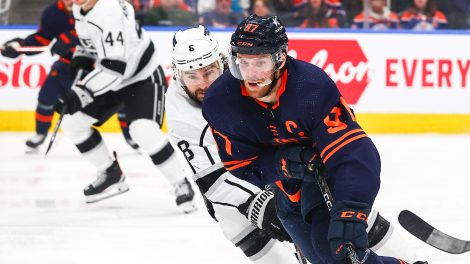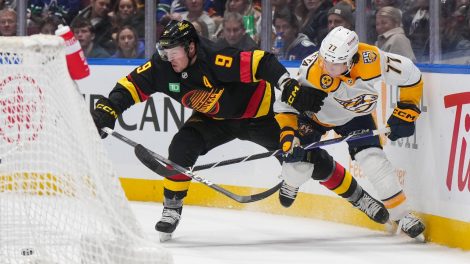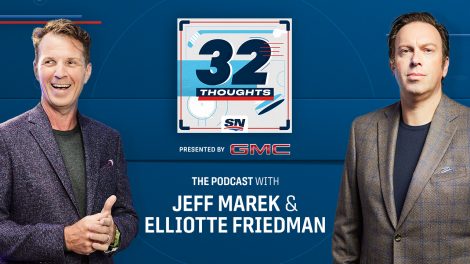Through the first quarter of the NHL season, the Oilers have been the hockey equivalent of a train wreck. It’s been ugly to watch, but there’s something about the nature in which it’s played out that’s also made it almost impossible to look away.
When things go wrong, especially to the degree in which they have for Edmonton this year, the natural tendency is to look around and try to find a scapegoat. There’s certainly been no shortage of that here already.
First came Connor McDavid, the team’s (read: league’s) best player, when his defensive play and decision-making with the puck were called into question. Then the attention shifted to the unit as a whole, when concerns were raised about their effort level and willingness to compete. The team’s seemingly infallible architect has begrudgingly started to take some of the heat himself. As has the local media and the role their regular interactions with the talent plays in all of this.
This drama has undoubtedly made for an entertaining soap opera, but it’s also diverted the attention away from what’s actually happening on the ice, and how the team differs from the one that finally got to the playoffs for the first time in a decade last season.
What’s particularly interesting is that even though the composition of the team isn’t all that different – aside from one notable name – the results have been, particularly at five-on-five:
| Metric | 2016-17 | 2017-18 |
|---|---|---|
| 5v5 Goals For/Hour | 8th | 21st |
| 5v5 Goals Against/Hour | 9th | 23rd |
| 5v5 Goals Differential | 6th | 26th |
(Data via Corsica)
The dip in performance at both ends of the ice has been jarring. Defensively, the loss of Andrej Sekera due to injury has been a massive factor as it’s thrown their pairings into the blender and forced players into roles for which they’re not best suited.
That’s only been compounded by Cam Talbot’s shaky play, as he seems to be succumbing to the insane workload that’s been put on his plate and is now on the injured reserve, which will force him to miss at least the next two games. He’s started 108 of the team’s past 120 games since the start of last season (including the playoffs), and it’s showed. Out of the 59 qualified goalies with at least five games played this year, Talbot is 36th in five-on-five save percentage and 46th overall.
As big of an issue as those numbers have been, at least it’s reasonably easy to explain when you look at his workload. There’s something about that which makes it easier to rationalize.
[snippet id=3317857]
It’s been tougher to reconcile the struggles that have plagued the Oilers on the other end of the ice when they’ve had the puck. The Oilers are third in shot attempts, sixth in shots on goal, but 26th in conversion rate, which shows up in the large discrepancy between their expected and actual goals scored. Whenever a team statistically profiles in this way the natural inclination is to believe there’s poor puck luck at play and that positive regression is on the horizon.
There’s no denying there’s some truth to that here, too, and it’d be foolish to dismiss it after everything we’ve seen and learned over the years. But digging into the Oilers’ case, there’s an even more troublesome, deep-rooted issue that’s been eating away at all those opportunities they’ve had, which possibly explains why the Oilers have been so bizarrely inept on offence.
The rate at which they’ve fired shots is encouraging, but an alarmingly high percentage of them have come from the players you don’t necessarily want to be the ones pulling the trigger this often:
| Team | 5v5 Shot Attempts | % of Shots by Defencemen | % of Shots by Forwards |
|---|---|---|---|
| EDM | 1206 | 42.45 | 57.55 |
| PHI | 1055 | 41.90 | 58.10 |
| SJS | 1046 | 40.63 | 59.37 |
| COL | 853 | 39.62 | 60.38 |
| OTT | 921 | 37.86 | 62.11 |
Those are the five teams whose defencemen take the highest percentage of their total team shots at five-on-five. Here are the five teams on the opposite end of the spectrum (more on this in a second):
| Team | 5v5 Shot Attempts | % of Shots by Defencemen | % of Shots by Forwards |
|---|---|---|---|
| DET | 1001 | 29.57 | 70.43 |
| ANA | 1009 | 29.83 | 70.17 |
| NJD | 980 | 31.12 | 68.88 |
| BOS | 1015 | 31.63 | 68.37 |
| VGK | 944 | 32.52 | 67.48 |
It’s a strange development for the Oilers, since their defencemen were taking just 35.35 per cent of the shot attempts last year, far closer to the usual league average (which has hovered just north of 33 per cent in recent years).
It’s tough to discern how much of that is on the players and the decisions they’re making on the ice, how much is just the random nature of hockey, and how much is actually the byproduct of the system McLellan wants his team to play.
On the one hand, you want to get the puck on net as often as possible because you never know what it could lead to next. With screens, rebounds, and unforeseen bounces, a harmless shot can often lead to good things. The reason we typically use raw shot attempts as a proxy for possession is because they provide us with a larger sample to analyze, but also because they have a strong positive relationship with future goals and, in turn, winning.
It seems overly simplistic, but all of those shots get lumped together because over the long haul these sorts of things tend to even out, and aside from the extreme outliers there tends to be a relatively narrow range of true shooting talent that most shooters fall into. The problem here is the Oilers might just be one of those extreme cases we need to adjust expectations for, because there’s a vast gap in conversion rates between forwards and defencemen.
Partly due to where they’re shooting from (with defenders traditionally near the point) and actual ability with the puck, defencemen get both a significantly smaller chunk of their attempts through to the target and beat the goaltender less when it does get there. Here’s the difference between the two when it comes to shooting the puck during the since the start of 2012:
| Metric | Forwards | Defencemen |
|---|---|---|
| Shots Attempted | 349,162 | 172,392 |
| Shots That Got Through | 273,385 | 113,559 |
| Shots That Hit Net | 200,481 | 77,716 |
| Goals Scored | 18,237 | 3,192 |
| % of Attempts That Hit Net | 57.42 | 45.08 |
| % of Attempts That Go In | 5.22 | 1.85 |
| Overall Shooting % | 9.10 | 4.11 |
(all data at five-on-five)
At the risk of turning this into yet another installment of the heated shot quality vs. shot quantity debate, I do think there’s something worth considering here. Or at least I’d like to believe there is, because it scratches a creative itch and opens the door for all sorts of possibilities.
Players and teams aren’t deviously ‘gaming Corsi’, and any suggestion to the contrary is patently false. As is the annual tradition of pointing to a team outperforming their shot metrics as proof that analytics don’t have a place in this sport.
But that doesn’t mean there aren’t more layers to this discussion. Not everything is created equal, so shots, the players taking them and the areas of the ice they come from matter. Coaches and the systems they’re employing from an Xs and Os perspective make a tangible difference. It’s a player’s league and talent will win out more often than not, but maybe there are subtle tactical adjustments that can either elevate or submarine a team.
All of that is what makes a team like the Los Angeles Kings such an interesting story, considering their struggles to turn shots into goals over the years, and how they’re finding more success now after all the noise they made about it over the summer. Or teams like the Golden Knights and Devils, who shouldn’t be nearly as effective offensively as they’ve been based on the talent they have on paper, but are somehow fifth and seventh in five-on-five offence for the year.
[snippet id=3636171]
Or, conversely, a team on the other end of the extreme like the Flyers, who should be better and more productive than they are, but are now going on a second straight year of misguidedly prioritizing what they’re doing in the offensive zone. Or the Sharks, who have relied far too much on Brent Burns bombing shots from the point, and aren’t looking so hot now that he’s come back down to earth.
For the sake of transparency the Islanders, Blues, and Lightning are all top-10 in the league in shots from the defence and are still second, third, and fourth in goals per hour. And the Red Wings, who are getting a higher percentage of their shots from the forwards than anyone in the league aren’t exactly running up the score on their opponents. This just goes to show that there isn’t only one way to succeed in this league, which is all part of the fun.
In the Oilers’ case, they’re eventually going to start scoring more goals based on the sheer volume of looks they’re getting and the fact they still have a bunch of talented offensive players who should be able to elevate the baseline level of performance for the team as a whole.
There’s reason to feel confident about that. But will that amount to enough goals to drag them out of the position they find themselves in and back into playoff contention? That is a more loaded question, and one that’ll ultimately be decided by whether they’re able to find a way to start tilting the odds in their favour by finding a happier marriage between the quantity and quality of shots they’re taking.
[relatedlinks]








